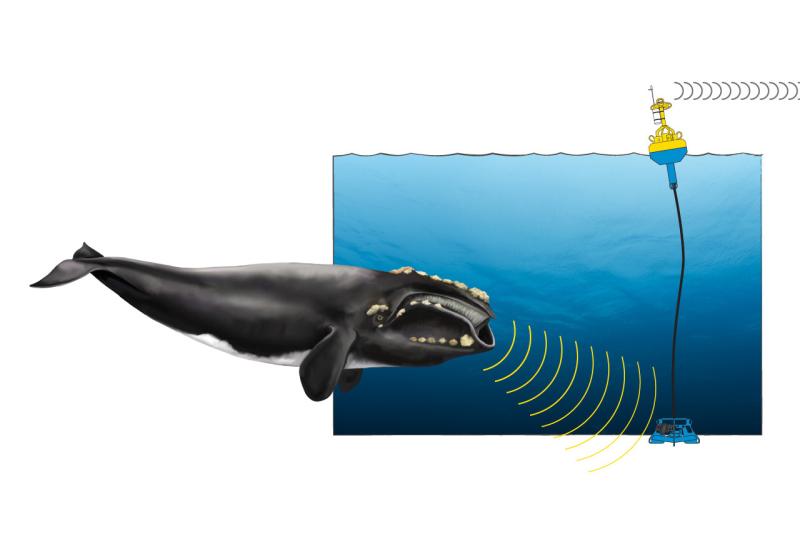Editor's Note December 4, 2023: Endangered North Atlantic right whales are approaching extinction. There are approximately 360 individuals remaining, including fewer than 70 reproductively active females. Human impacts continue to threaten the survival of this species.
Conservation Issue
NOAA scientists have documented changes in the North Atlantic right whales’ distribution (population density) and migration patterns over the past decade. It isn’t yet clear what is causing these changes; warming oceans may be affecting the location and abundance of the zooplankton the whales need to survive, or human activities may be impacting the whales. Whatever the reasons, knowing where these whales are and where they are likely to be is crucial for understanding potential conflicts with fisheries and ships in order to make location-based conservation measures effective (e.g., time-area closures for fishing or vessel speed restrictions).
Passive acoustic monitoring is one of the powerful tools NOAA experts use for understanding and monitoring shifts in North Atlantic right whales’ movements. Using technologies like autonomous listening gliders, floating high-tech buoys, or bottom-mounted recorders deployed along the coast, researchers can record whale calls and obtain new insights into range expansion or decline and changing distribution patterns.
Meet the Expert

Learn more about North Atlantic right whale acoustic monitoring in this Q&A with NOAA zoologist Sofie Van Parijs, who started NOAA’s Northeast passive acoustic research group in 2006.
What have you learned about North Atlantic right whales’ distribution and migration patterns through your passive acoustic research?
We’ve learned a lot recently—there have been some fascinating surprises. We’ve seen major shifts in their migration patterns and in where they’re spending their time. Fewer are going to northern Maine, while more are gathering farther north near the Gulf of St. Lawrence in Canada—a busy shipping and fishing area. They’ve also increased the time they spend in the mid-Atlantic region. Previously, we thought most North Atlantic right whales went to calving grounds off Florida and Georgia in the winter and then migrated to northern feeding grounds off Maine in the summer. But it turns out that not all of these whales migrate each year; they’re all along the East Coast, especially during winter.
How did you learn about these major shifts?
All of these findings are from a big passive acoustic monitoring study we completed in 2017 in collaboration with 19 organizations (including the Stellwagen Bank National Marine Sanctuary, Duke University, and the Woods Hole Oceanographic Institution). The study was based on more than 35,600 days of data that NOAA and these partners collected and combined from 324 listening devices between 2004 and 2014. This was the first long-term passive acoustic study looking at the right whale’s entire habitat range.
How does this new knowledge about right whales’ distribution and migration patterns help address the crisis they’re facing?
Scientists and resource managers can use this information to better identify and then protect areas that are crucial for this species. For example, because ship strikes are one of the leading causes of North Atlantic right whale deaths, it’s important for resource managers to know when and where there’s a greater risk of ship strikes so they can set up effective protections.
Since you started at NOAA over a decade ago, what are some technological changes you’ve seen in your work?
Over the past decade, there have been a lot of advancements in acoustic monitoring technologies, in large part thanks to collaborative innovation. For example, NOAA recently partnered with WHOI to develop autonomous, gliding recorders that have acoustic detection software on them which actively listens for North Atlantic right whales’ calls around the clock and automatically identifies them. This means we can respond to information on right whales quickly and direct research efforts aimed at tracking an individual’s health and the population’s abundance. In turn, this information is more quickly available to inform management measures. These health assessments are particularly critical right now because so few North Atlantic right whales are left.
Based on your research, how are North Atlantic right whales different from other whales?
From our acoustic monitoring and other tracking efforts, we know that North Atlantic right whales are a true coastal species, directly overlapping with the densest areas of human activity. This puts them at greater risk than other whale species like blue whales, which are more of a deep-water species. Like all marine species, they’re an important part of the ocean ecosystem. And having a healthy ocean is something I hope we can all aspire to and work toward.
Meet Eros Eros is a North Atlantic right whale born in 2007. His mother is Aphrodite. When he was a year old, Eros was found entangled in fishing gear off Florida and was partially disentangled with the help of an expert disentanglement team. He later shed the remaining gear. The scar visible on his body is a healed laceration from a boat propeller in 2012. Eros has been spotted frequently by researchers from Nova Scotia to Florida. He was last seen in 2016. Credit: Christin Khan/NOAA, MMPA permit #775-1875. |






